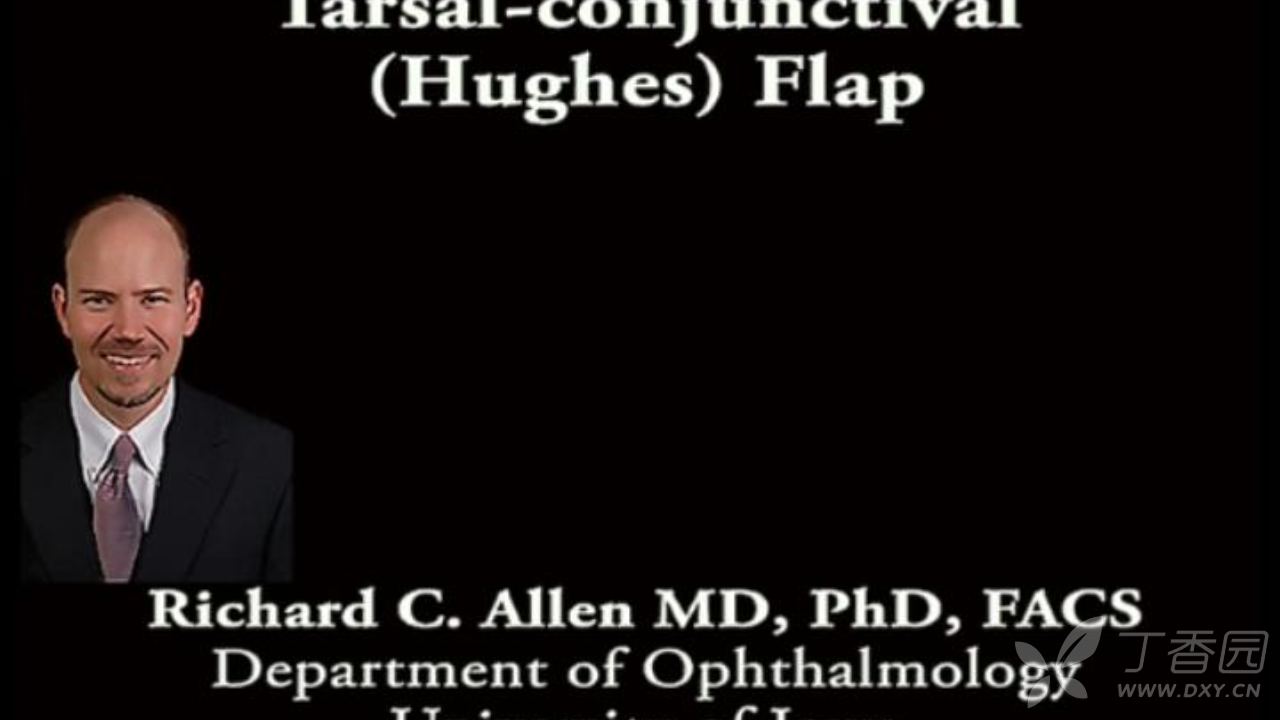睑结膜瓣并皮肤移动或移植片(HUGHIES术)
睑结膜瓣并皮肤移动或移植片(HUGHIES)(图6.13)

图6.13
原理
对于治疗下睑缘缺损,睑结膜瓣比游离移植片更可取,因为它在愈合阶段提供了垂直提拉,并能支持皮肤移植片。通常需要如此,因为下睑的多余皮肤比上眼睑的少。上睑的部分睑板带结膜蒂被向下引出并缝合到下睑缺损处。它被移动来的皮肤或全层皮肤移植片覆盖。二期手术中切除结膜蒂,重建下睑缘。通过保持上睑板下部4mm的完整,保持了上睑缘的完整性。
适应症
下睑睑缘缺损(图6.13a)。
方法
1. 将缺损边缘相向牵拉以代偿由于轮匝肌收缩和内外眦韧带松弛,测量减少的下睑缺损的水平范围。
2. 将上睑外翻,在睑缘上方4mm处穿透睑板做一水平切开,切口长度与缩小的下睑缺损相同(图6.13b)。
3. 在水平切口两侧穿透睑板上各做一垂直切开,向上延伸抵达结膜内。
4. 解剖并游离睑板结膜瓣,使其在无张力的情况下前移至下睑缺损处(图6.13c)。
5. 用6’0’长效可吸收缝线将瓣缝合到缺损处(图6.13d,e)。
注意:如果睑结膜瓣上的睑板不够大,不足以填补下睑水平缺损,可行外眦韧带下肢的外眦松解。如果没有可移动的眼睑外侧片段,可以考虑从眶外侧缘转位一个大小合适的骨膜瓣。
6. 用局部移动后的皮肤覆盖未处理的睑板前表面(图6.13f)或如前所述用合适的全层皮肤移植片(图6.13g)。
7. 当修复看起来良好愈合时(通常大约3周后)分开结膜蒂。烧灼新的未处理的睑缘,使其与剩余的切除睑缘保持一致。与如果将其缝合相比,它会肉芽组织形成,产生颜色更浅更光滑的睑缘(图6.13h)。
8. 上睑缺损开放不予处理,使之肉芽组织形成,但上睑缩肌必须游离、后退,最好牵引上睑24小时,并必要时进行后续按摩以纠正任何眼睑退缩。
并发症
增厚的红色睑缘:如果对分离的瓣进行烧灼并使其肉芽组织形成,则可降低发生这种情况的风险。如果发生,应将多余的组织切除,睑缘变薄并烧灼。
上睑退缩:如果不能通过睫毛牵引和按摩来控制,就需要打开上睑结膜伤口,并将缩肌正式后退。
(以上内容翻译自《A Manual Of Systematic Eyelid Surgery 》第三版)。
下面分享Richard Allen教授讲解的Hughes术教学视频演示。


This is Richard Allen at the University of Iowa. This video demonstrates the use of a tarsoconjunctival or Hughes flap to repair a lower eyelid defect. As is noted, the defect is full-thickness and involves approximately 75% of the width of the lower eyelid. The defect is measured with calipers. A subciliary incision is then made extending from the lateral edge of the defect to the lateral canthus. Dissection is then performed between the orbicularis muscle and the orbital septum to the inferior orbital rim. The intent of this dissection is to provide mobilization of a myocutaneous advancement flap to cover the Hughes flap, rather than using a skin graft. Dissection is carried out in a preperiosteal fashion inferior to the inferior orbital rim.
A 4-0 silk suture is placed through the upper eyelid and the eyelid is everted over a malleable retractor. A marking pen is used to make a mark 4 mm superior to the eyelid margin. The measured length of the defect is then marked. A 15 blade is then used to make an incision through the tarsus along the marking. Dissection is then performed between the anterior surface of the tarsus and the pertarsal orbicularis muscle. Westcott scissors are then used to make vertical incisions at each end of the flap. Further dissection is performed with a thermal cautery between the Mullers muscle and conjunctiva. As you can see, the dissection here is very thin and it is not uncommon to make a button hole in the conjunctiva. Further dissection is carried out so that the flap can be placed into position to repair the posterior lamella. The remaining edge of the tarsus medially is then sutured to the flap with interrupted 5-0 vicryl sutures. Two sutures are placed and then tied. The flap is then secured to the remaining lateral tarsus, again with two 5-0 vicryl sutures. The portion of the flap that corresponds to the future lid margin is then sutured with 7-0 vicryl sutures. Dissection is then carried out with the thermal cautery inferiorly between the conjunctival and lower lid retractors. Release of the lower lid retractors is important to prevent post-operative lid retraction as it is important to dissect between the Mullers muscle and conjunctiva in the upper lid. The conjunctiva is then sutured to the inferior edge of the flap with a running 7-0 vicryl suture. This then completes repair of the posterior lamella.
In order to advance the anterior lamella, a preperiosteal midface lift is performed. This is performed by engaging the SOOF which is then sutured to the periosteum of the inferior orbital rim with 4-0 vicryl sutures. This results in adequate mobilization of the anterior lamella so that it can cover the tarsoconjunctival flap. The anterior lamella is then sutured to the Hughes flap, and this is performed with a running horizontal mattress suture using 7-0 vicryl suture. This advances the flap so that the upper edge of the anterior lamellar flap is at the edge of the Hughes flap. The subciliary incision is then repaired with the same 7-0 vicryl suture. Additional 7-0 vicryl sutures are then placed to fixate the upper edge of the anterior lamellar flap to the upper edge of the Hughes flap. At the conclusion of the case, the eyelid appears to be in good position. The patient will be seen in approximately one week. A patch is placed post-operatively for approximately 2-3 days. There is a small button hole in the conjunctiva which is of no consequence. Release of the Hughes flap will be performed in approximately 2-3 weeks. If a skin graft were used, one might wait as long as a month.















































